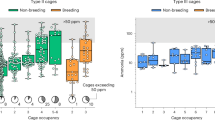Abstract
This report describes for the first time the effects of long-term continuous exposures of animals to small air ions and D.C. electric fields. In this study we exposed 200 female NAMRU mice (25/cage) to the following conditions: ± high ions (2×105/cm3), ± low ions (2×103/cm3), ± field only and ground (ion depleted, no field). Specially designed cages provided a defined D.C. field of about 2 kV/meter in ionized environments, with somewhat lower values in the field only cages. Detailed mapping of ion flux originating from a tritium foil generating system (multiple sources in an overhead plate) indicated a well defined, but heterogenous pattern with eight peak areas. Using a 100 cm2 probe, ion flux values ranged from 10−12–10−14 A/cm2, with an average flux of 8.7±6.8×10−13 A/cm2 in high negative ion cages, with good reproducibility between cages.
Measurements of serum glucose, cholesterol, and urea nitrogen (samples taken every three months) showed a number of small but consistent and statistically significant differences between animals maintained in different environments during the first year of exposure. Serum globulin and whole blood serotonin, however, did not show any significant environmental effects. Interestingly, pairwise comparisons between high negative and low negative ion conditions, or between high positive and low positive ion conditions, or between the two ground conditions, revealed no significant differences between cages. This argues for a similarity of environmental responses for the mice maintained in each of the compared conditions.
The results of a multiple classification analysis for the entire first year showed a preponderence of effects for the ionized cages, although other conditions also had highly significant differences as compared to the grand mean value. While this study has shown effects of only small magnitude (compared to normal physiological variations) in the female NAMRU mice studied here, the significance of these results strongly validates the precept of long-term air ion effects in animals. Given the known variability of different species and strains, future studies will have to determine the actual range of responsiveness of animals exposed on a long-term basis to defined air ion and electromagnetic environments.
Similar content being viewed by others
References
BRACKEN, T. D. (1979): Electrical Parameters of the High-Voltage Direct-Current Transmission-Line Environment, Biological Effects of Extremely Low Frequency Electromagnetic Fields. Proc. 18th Ann. Manford Life Sciences Symp., Pub. Technical Information Center, U.S. Dept. of Energy, 485–500.
CHARRY, J. M. and HAWKINSHIRE, F. B. (1981): Effects of Atmospheric Electricity on Some Substrates of Disordered Social Behavior. J. Pers. Soc. Psyc., 41: 185–197.
DIAMOND, M. C., CONNOR, J. R., ORENBERG, E., BISSELL, M., YOST, M. and KRUEGER, A. P. (1980): Environmental Influences on Serotonin and Cyclic Nucleotides in Rat Cerebral Cortex. Science, 210: 652–654.
KELLOGG, E. W. III, YOST, M. G., BARTHAKUR, N. and KRUEGER, A. P. (1979): Superoxide Involvement in the Bactericidal Effects of Negative Air Ions onStaphylococcus albus. Nature, 381: 400–401.
KELLOGG, E. W. III, YOST, M. G. and KRUEGER, A. P. (1980): Superoxide Involvement in Negative Air Ion Effects. Nature, 288: 739–740.
KELLOGG, E. W. III (1984): Air Ions: Their Possible Biological Significance and Effects. J. Bioelectricity. In press.
KRUEGER, A. P., KOTAKA, S. and ANDRIESE, P. C. (1962): Some Observations on the Physiological Effects of Gaseous Ions. Int. J. Biometeor., 6: 33–48.
KRUEGER, A. P., ANDRIESE, P. C. and KOTAKA, S. (1963): The Biological Mechanism of Air Ion Action: The Effect of CO+ 2 in Inhaled Air on the Blood Level of 5-Hydroxytryptamine in Mice. Int. J. Biometeor., 7: 3–16.
KRUEGER, A. P., KOTAKA, S., NISHIZAWA, K., KOGURE, Y., TAKENOBU, M. and ANDRIESE, P. C. (1966): Air Ion Effects on the Growth of the Silkworm (Bombyx mori L.) Int. J. Biometeor., 10: 29–38.
KRUEGER, A. P., ANDRIESE, P. C. and KOTAKA, S. (1968): Small Air Ions: Their Effect on Blood Levels of Serotonin in Terms of Modern Physical Theory. Int. J. Biometeor., 12: 225–239.
KRUEGER, A. P. (1982): Air Ions as Biological Agents — Fact or Fancy, Part I and Part II. Imm. and All. Prac., IV: 129–140, 173–183.
YOST, M. G., KELLOGG, E. W. III: Design and Construction of Cage Environments for Air Ion and Electric field research. Int. J. Biometeor., Submitted for publication.
Author information
Authors and Affiliations
Additional information
Deceased December 8, 1982.
Rights and permissions
About this article
Cite this article
Kellogg, E.W., Yost, M.G., Reed, E.J. et al. Long-term biological effects of air ions and D.C. electric fields on Namru mice: First year report. Int J Biometeorol 29, 253–268 (1985). https://doi.org/10.1007/BF02189657
Received:
Revised:
Issue Date:
DOI: https://doi.org/10.1007/BF02189657




